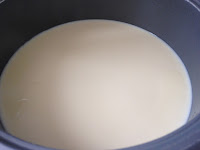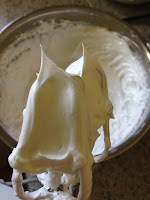Some people call this snack/dessert the peanut sesame glutinous rice balls or glutinous peanut balls or loh mai chi or peanuts mochi. I occasionally make this as supper for my church friends when I attended the Saturday night group. This snack/dessert is really similar to the Japanese mochi but the "snow skin" is actually softer in texture as compare to the Japanese mochi. Honestly speaking, if you want to make this, you got to be very calm and patient especially when wrapping fillings like toasted crushed peanuts and sesame seeds.
Now, about the making...
For the skin:
250g glutinous rice flour
2 cups of water
100g sugar
1.5 tsp oil (optional)
For filling:-
300g toasted crushed peanuts
50g toasted sesame seeds
100g sugar (or castor sugar)
Flour for coating:-
80-100g rice flour
Note: This recipe makes about 24-25 glutinous peanut balls
The steps:-
1) To make the toasted peanuts and sesame seeds, you could either place the crushed peanuts in oven or stir fry them until aromatic. (Note: Beware of burning the peanuts if not careful.)

- I usually pan fry the crushed peanuts and sesame seeds instead of placing them in oven. As I bought the cooked crushed peanuts, all I need is to stir fry them in an ungreased pan for maybe about 5-10min with medium low to medium heat until you could smell the nice aroma of the peanuts and sesame seeds.
- Remove the fried / toasted peanuts and sesame seeds from heat. Leave it to cool for awhile before placing them in a container.
2) Once the toasted peanuts and sesame seeds are cooled, add in the castor sugar and mix well. Note: Do not cover the container with the lid until it is completely cooled.

3) Next, you could start making the skin for the glutinous balls. In a bowl, put in all the ingredients for the skin. Stir with a spoon until well mixed. Then, pour this liquid mixture into a lightly greased steaming tray and steam for about 30-35minutes with medium heat.

 The look of the cooked glutinous rice dough skin
The look of the cooked glutinous rice dough skin
4) Once the skin for the glutinous peanut balls is cooked, remove it from heat and leave aside to cool.
5) While waiting, let's prepare the cooked rice flour for coating the glutinous peanut balls during the wrapping process. All you need to do is to place the rice flour in an ungreased pan and stir fry it for about 10-15 minutes with medium low or low heat until cooked. (Note: To test the flour, just touch some of the rice flour in the pan and feel it. If you feel that the flour is quite dry but smooth, then it is considered cooked. Do not stir fry the rice flour with high heat to avoid burning or browning the rice flour.)
I guess the hardest part for me is the wrapping process as I have not found any faster way to wrap the filling. And, if you are too greedy by placing too much of the filling, the dough skin might break and hard to be rescued...
The wrapping steps...
1) Removed the cooled glutinous rice dough from the steaming tray. Flour the dough with some cooked rice flour and cut it into squares ie about 2.5cm x 2.5cm each.
2) Take one portion of the dough skin, press slightly in the middle with your thumb to make a inverted bell curve.
3) Slowly put in a quarter teaspoon of filling and press it gently with your thumb.
Note: If you feel sticky, flour a little cooked rice flour around the sticky skin part.
**Repeat this step 4 to 5 times with a quarter teaspoon of filling each time. Note: Total filling for each glutinous peanut balls is between 1 - 1.5 tbsp of filling. Do not place too much of filling as it might break the skin when sealing the dough ball.
** For easier sealing of the dough ball, hold the filling in place by gently pressing on it with one of your thumb while the other hand working on sealing the edges to make a round shape ball.
4) To finish the process, coat the wrapped balls with some cooked rice flour before putting into a
container.





















































